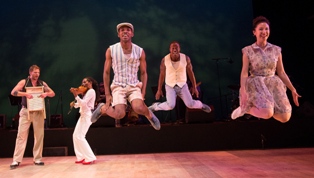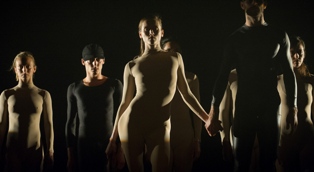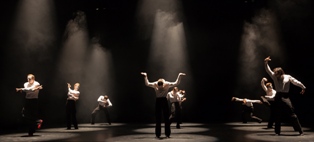When Samuel Murez discovered Shakespeare as a kid, he was entranced by the extravagant language, dashing actors and epic action. As he grew older, he developed a fuller understanding and deeper appreciation of the poet’s genius. But, he says, he’s never lost the wide-eyed wonder of those first encounters.
That’s how Murez hopes the work of 3e étage, the dance company he founded in 2004, will resonate with audiences: accessible to the uninitiated and more deeply rewarding for cognoscenti. This troupe, which made its second appearance at Jacob’s Pillow Dance Festival this month, operates on several levels anyway. Its eleven members are all soloists in the venerable Paris Opera Ballet (the group’s name refers to the theater’s third-floor dance studio) but its avowed purpose is to shake off the strictures and even spoof the august traditions of its 500-year-old parent institution.
That approach, in my experience, is true of most of the work on view at the Pillow. This festival on a Berkshire hilltop, now in its ninth decade, has from the beginning focused on breaking with old forms and, equally, breaking down barriers to appreciation of the dance. The three performances I’ve seen recently all shared that attitude, in quite different ways and, to my eyes, with varying success.
If you think Jacob’s Pillow is all about sinuous modern dance, you ain’t seen nuthin’ yet. Dorrance Dance is all about tap. Michelle Dorrance is a tall, lithe white woman who heads a mostly black ensemble which “aims to honor tap dance’s uniquely beautiful history in a new and dynamically compelling context, not by stripping the form of its tradition, but by pushing it: rhythmically, aesthetically and conceptually.”

Dorrance’s homage to “America’s most long-standing indigenous jazz vernacular” owes more to Bill “Bojangles” Robinson than to Fred Astaire, and embraces multiple allied dance forms, from soft-shoe (and no-shoe) to Lindy to break. “The Blues Project,” the new show they premiered at the Pillow late last month, featured an original score performed live by the marvelous Toshi Reagon leading a four-piece onstage band.
Steeped in blues but covering many territories in the jazz universe, Reagon’s songs also deeply reflect on the African-American experience. Check out the lyric “Nothing lights a fire like a dream deferred,” which channels Langston Hughes while turning his lament into a call to arms. And the music doesn’t merely supply rhythms and suggest moods. Notes and steps were created together, so the taps are not only laid into the percussive soundtrack, but the dancers’ feet find the beat inside the beat of the musical cross-rhythms. What’s more, these nine dancer-athletes aren’t simple hoofers. Though planted at floor level, the routines engage every part of the body in fitful, flexuous, sometimes frantic movement—which makes them a perfect fit for the Pillow.
Like 3e étage, L-E-V is the offshoot of an established institution, in this case, Israel’s Batsheva Dance Company. But unlike the Murez approach, co-founders Sharon Eyal and Gai Behar have extended rather than departed from the parent company’s aesthetic. That would be what Batsheva’s Ohad Naharin calls Gaga—no relation to the Lady of that name, nor, really, to the lowercase meaning of the term, implying wild enthusiasm, reckless ardor and/or the demented end of crazy.
What I saw onstage in L-E-V’s concert at the Pillow last month was neither enthusiastic nor adoring, and could be called demented only the sense that it was exceedingly strange. Naharin describes his own Gaga as “an innovative movement language … which emphasizes the exploration of sensation and availability for movement.” In House, the piece L-E-V brought to the Pillow, the language this movement was articulating seemed to originate in outer space.

In her curtain speech, the festival’s director, Ella Baff, described the work as “a landscape of the mind— provocative, evocative, intense.” It was all those things and more—for example, dark (intense shadowy lighting in clouds of haze), slow-moving (evocative of sleepwalkers or zombies) and, yes, provocative in its semi- and in one case total nudity. In a long initial sequence, dancers in transparent-unitards moved in serpentine sinuosity or writhed in jerks and wriggles, like newly created beings emerging from their cocoons. We also glimpsed transvestite and transgender images, extremes of pain and fear contrasted with mannequin-like vacuity, and fleeting moments of almost-connection between not-quite-humans, to the accompaniment of Ori Lichtik’s pulsating electronic score.
It was fascinating, in a horrified-fascination kind of way, but for me, at least, it didn’t connect, either viscerally or thoughtfully. But I suspect the connoisseur/newbie continuum of appreciation can still apply here, for those acquainted with the subtleties of Gaga, on the one hand, or fans of apocalyptic dystopia on the other.
3e étage has a delightfully satiric relation to the tradition that spawned it. Much of the program we saw at the Pillow looks at classical ballet through an affectionately ironic lens. It began with an almost-straightforward, and quite astonishing, display of technique—a brilliant corps de ballet establishing its world-class credentials before spinning off into revisionism and outright parody.
The latter tactic was on view in a male quartet who vied to outdo each other in the balletic equivalent of a break-dance battle, a comical show-off competition of leaps and spins, ending with a deliciously irreverent caricature of the dance-world curtain call. There was also comedy in a Chaplin-inspired sketch in which two men wooed the same woman according to an instruction book for hitting on girls, and more poignant humor in the figure of the shabby whitefaced Trickster—a mute stagehand who at one point did a sweeping-the-follow-spot routine, a salute to the sad-clown genius Emmett Kelly.

In a program that ran the gamut from somber to lighthearted to crazed, the soundscape was as eclectic as the movement. Pieces by Brahms and Beethoven alternated with original compositions interlaced with sound effects. One number had no music, just the voice of the stage manager calling light cues, as we listened to the amplified breathing of the dancers—a literal demonstration of Murez’ desire not to fool us into thinking that great dance is effortless just because it looks that way. It’s hard work, as the dancers’ muffled grunts attested. Murez says he makes “inordinate” demands on the performers, pushing them to the limit and at the same time letting us witness the effort. It’s better to fail, he’s said, than to achieve some kind of glib perfection. Which in itself is yet another transgressive gesture toward the classical tradition.
After this thrilling, accessible-yet-complex performance, I’m looking forward to the troupe’s troisième (3e) visit to Jacob’s Pillow.
Dorrance Dance and L-E-V photos by Christopher Duggan, courtesy Jacob’s Pillow Dance; 3e étage photo by Karli Cadel, courtesy of Jacob’s Pillow Dance.
If you’d like to be notified of future posts, email StageStruck@crocker.com


